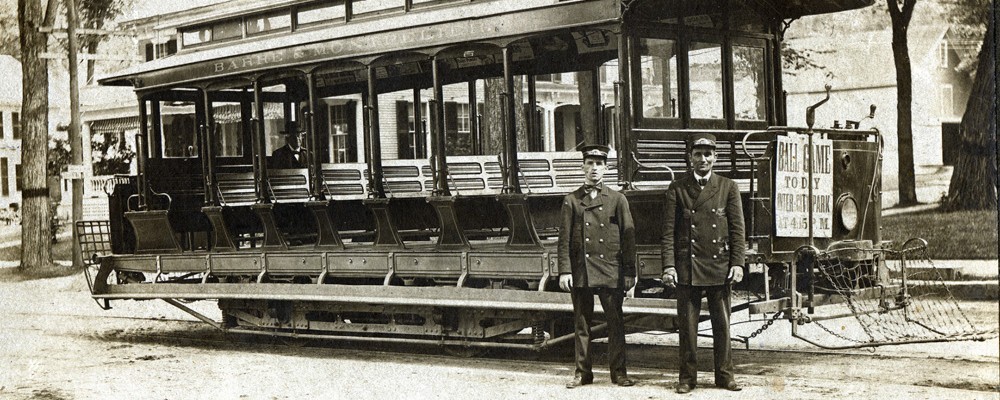The Age of Trolleys, 1901

In the years before the First World War, the electric trolley, spitting blue sparks, saw its heyday in Vermont, also its decline. The little four-wheel “bobbers” and the big eight-wheel, two-trucked interurbans carried 10 million passengers a year.
Oral history transcriptions
Click a name below for more information. All transcripts are in PDF format.
- Kenneth Bessett, Sr.
- Merritt Carpenter
- Albert Spaulding
Background information
The Winooski and Burlington Horse Railroad Company began operation in 1885, the first street railroad in the state. Two years later the horses were sent off to pasture and the trolleys were electrified. St. Albans, Rutland, Bennington, Barre and Montpelier, Brattleboro, Bellows Falls, Springfield, Waterbury and Stowe all had their traction companies. For the price of a nickel, you could ride in winter on wicker seats inside the closed car, its windows steamed moist and cloudy white, or in summer in the open cars on wooden benches which ran the width of the car without a center aisle. The conductor took the fares and the motorman drove the trolley and pumped the foot-operated alarm gong that clonked its noisy warning to pedestrians.
Within his quick reach was a line controlling the big, flaring cowcatcher or fender. This grimacing contrivance, looking like a misplaced bedspring, was normally in the “carry” position, its point raised a few inches above the rails. But with a flick of his hand, the motorman could drop the fender into contact with the rails and hope to scoop up weary dogs or unwary children.
(Albert C. Spaulding, “Trolleys,” Vermont Life, Spring 1964)
The trolley coming out of Swanton liked to race the train coming out of Fonda Junction, where there was a long downcline. Once it started rolling, the trolley could achieve a speed of 50 mph. One time it careened down the downcline pulling ahead of the train to the cheering of the passengers holding on for dear life and egging on the trolley motorman. At the curve at the bottom of the hill where the trolley is supposed to slow down and veer off, this racing trolley just kept going on, straight through the curve, across the field toward the river, almost hitting the plodding train before it finally stopped upright and victorious.
Bellows Falls was a sizable railroad junction and had its own railway switcher. During the winter, on the Bellows Falls-Saxtons River Traction Company line, the trolley hauled pulp wood from Saxton River down to Bellows Falls where the switcher took it across the river to the pulp mill in New Hampshire. The trolley line ran right down the center of town. One winter night in Bellows Falls there was a spectacular fire. The fire fighters pumped quite a lot of water on the fire and the run-off froze all over the street and trolley tracks. In the morning the trolley company sent a little work care down the line with men equipped with axes to chop the ice off the tracks.
While they were still working on the ice, the traction company engine, pulling two flatbed cars loaded with pulp wood appeared at the top of Main Street. The engineer saw the commotion below on the tracks but not before the cars topped over the edge of the hill and began their down run. The shouting arm-waving men jumped off the pulp load, the ice choppers skedaddled, and the pulp load smashed into the little traction engine. Everything went off the tracks and over, and pulp wood spewed out in all directions. What a miserable mess! It took days to pick up all that pulp wood by hand, and chisel off the rest of the ice to get equipment in order to bring in equipment to right the cars and get them back on track again.
All week long trolleys carried workers and shoppers on a regular busy schedule. To keep the trolleys busy on weekends, the traction companies developed parks at the ends of the line, such as Ethan Allen Park in north Burlington and Benjamin’s Falls Park between Montpelier and Barre that used to be near the little stream that runs by the State Garage. Trolley patrons packed up their picnic baskets and go out to the par by trolley for a family outing. Former ferry boat captain Merritt E. Carpenter of Burlington remembered going to Ethan Allen Park out North Avenue in Burlington for the end-of-school picnics. As soon as all the youngsters were unloaded with the picnic hampers and games, he would sneak away, and taking a hoarded nickel from his pocket, ride the clanging, bell-ringing trolley all the way to the other end of the line and back.
Note: The trolley car was invented in 1834 by Thomas Davenport, a blacksmith in Brandon, Vermont, who, according the Albert Spaulding, “built a tiny electric motor on wheels that propelled itself around a little track, like the engine of a toy train.”
—Eleanor Ott
March 1987
Further reading
Albert C. Spaulding, “Trolleys,” Vermont Life, Spring 1964, XX-XX.
Citation for this page
Woodsmoke Productions and Vermont Historical Society, “The Age of Trolleys,” The Green Mountain Chronicles radio broadcast and background information, original broadcast 1988-89. https://vermonthistory.org/age-of-trolleys-1901